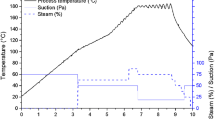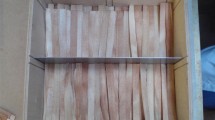Abstract
The paper discusses the influence of methylene diphenyl diisocyanate (MDI) content on mechanical properties of thermally post-treated single-layered oriented strand boards (OSB). The OSB differed in adhesive content (3, 4 and 5%) and the high temperature (HT) level of the thermal modification (TM) (untreated, 160, 175 °C). To characterise the mechanical behaviour of the OSB, the modulus of rupture (MOR), modulus of elasticity (MOE), and internal bond (IB) of dry and boiled specimens were determined. In addition, the adsorption and desorption isotherms were investigated. The hygroscopic sorption isotherms were calculated according to the Hailwood-Horrobin equation. It was observed that the MOR and the IB of the post-treated OSB are significantly increased with higher MDI content. An increase of the MDI content from 3% up to 5% is not sufficient to compensate the loss of strength caused by TM. However, an increase of MDI-content of about 1% compensates the significant loss of IB of dry and boiled specimens. The MOE is not influenced by TM. With increased adhesive content, thermally treated and untreated specimens show slightly higher values. The thermal post-treatment of OSB alters the wood-water-interaction. The hygroscopicity is reduced. The higher the HT level, the lower is the sorption behaviour. It was also detected that a higher MDI content does not influence the hygroscopicity.




Similar content being viewed by others
References
Aro MD, Brashaw BK, Donahue PK (2014) Mechanical and physical properties of thermally modified plywood and oriented strand board panels. Forest Prod J 64(7/8):281–289
Bonigut J, Krug D (2011) Properties of thermally modified oriented strandboards (OSB). In: Forest products society 65th international conference. Proceedings, Portland
Bonigut J, Krug D, Stephani B (2012) Properties of thermally modified medium-density fibreboards. Holzforschung 66(1):79–83
Bonigut J, Krug D, Stuckenberg P (2014) Dimensional stability and irreversible thickness swell of thermally treated oriented strandboards (OSB). Eur J Wood Prod 72(5):593–599
Boonstra MJ, Tjeerdsma B (2006) Chemical analysis of heat treated softwoods. Holz Roh Werkst 64(3):204–211
Del Menezzi CHS, Tomaselli I (2006) Contact thermal post-treatment of oriented strandboard to improve dimensional stability: a preliminary study. Holz Roh Werkst 64(3):212–217
Del Menezzi CHS, de Souza RQ, Thompson RM, Teixeira DE, Okino EYA, da Costa AF (2008) Properties after weathering and decay resistance of a thermally modified wood structural board. Int Biodeterior Biodegrad 62(4):448–454
Del Menezzi CHS, Tomaselli I, Okino EYA, Teixeira DE, Santana MAE (2009) Thermal modification of consolidated oriented strandboards: effects on dimensional stability, mechanical properties, chemical composition and surface color. Eur J Wood Prod 67(4):383–396
EN 1087 (1995) Particleboards—determination of moisture resistance—Part 1: Boil test
EN 310 (1993) Wood-based panels—determination of modulus of elasticity in bending and of bending strength
EN 319 (1993) Particleboards and fibreboards—determination of tensile strength perpendicular to the plane of the board
EN 322 (1993) Wood-based panels—determination of moisture content
EN 323 (1993) Wood-based panels—determination of density
Esteves B, Domingos I, Pereira H (2008) Pine wood modification by heat treatment in air. BioResources 3(1):142–154
Hailwood AJ, Horrobin S (1946) Absorption of water by polymers: analysis in terms of a simple model. Trans Faraday Soc 42:B084-B092
Hartley ID, Wang S, Zhang Y (2007) Water vapor sorption isotherm modeling of commercial oriented strand panel based on species groups and resin type. Build Environ 42(10):3655–3659
Hill CA, Ramsay J, Keating B, Laine K, Rautkari L, Hughes M, Constant B (2012) The water vapour sorption properties of thermally modified and densified wood. J Mat Sci 47(7):3191–3197
Jalaludin Z, Hill CA, Xie Y, Samsi HW, Husain H, Awang K, Curling SF (2010) Analysis of the water vapour sorption isotherms of thermally modified acacia and sesendok. Wood Mat Sci Eng 5(3–4):194–203
Kollmann F, Fengel D (1965) Changes in chemical composition of wood by thermal treatment. Holz Roh Werkst 23(12):461–468
Lee SH, Lum WC, Zaidon A, Maminski M (2015) Microstructural. mechanical and physical properties of post heat-treated melamine-fortified urea formaldehyde-bonded particleboard. Eur J Wood Prod 73(5):607–616
Mendes RF, Júnior GB, de Almeida NF, Surdi PG, Barbeiro IN (2013) Effect of thermal treatment on properties of OSB panels. Wood Sci Technol 47(2):243–256
Mohebby B, Ilbeighi F, Kazemi-Najafi S (2008) Influence of hydrothermal modification of fibers on some physical and mechanical properties of medium density fiberboard (MDF). Holz Roh Werkst 66(3):213–218
Neimsuwan T, Wang S, Taylor AM, Rials TG (2008) Statics and kinetics of water vapor sorption of small loblolly pine samples. Wood Sci Technol 42(6):493–506
Ohlmeyer M, Kruse K (1999) Hot stacking and its effects on panel properties. In: European Panel Products Symposium. 3. Proceedings, Llandudno pp 293–300
Ohlmeyer M, Paul W (2010) Optimierung der Eigenschaften von Holzwerkstoffen mit Hilfe von thermischen Modifizierungsmethoden (Optimisation of properties of wood products by means of thermal modification) (In German). vTI, p 228
Okino EY, Teixeira DE, Del Menezzi CH (2007) Post-thermal treatment of oriented strandboard (OSB) made from cypress (Cupressus glauca Lam.). Maderas Cienc Tecnol 9(3):199–210
Olek W, Majka J, Czajkowski Ł (2013) Sorption isotherms of thermally modified wood. Holzforschung 67(2):183–191
Paul W, Ohlmeyer M, Leithoff H, Boonstra MJ, Pizzi A (2006) Optimising the properties of OSB by a one-step heat pre-treatment process. Holz Roh Werkst 64(3):227–234
Paul W, Ohlmeyer M, Leithoff H (2007) Thermal modification of OSB-strands by a one-step heat pre-treatment–Influence of temperature on weight loss, hygroscopicity and improved fungal resistance. Holz Roh Werkst 65(1):57–63
Pétrissans M, Gérardin P, Serraj M (2003) Wettability of heat-treated wood. Holzforschung 57(3):301–307
Richards RF, Burch DM, Thomas WC (1993) Water vapor sorption measurements of common building materials. Trans Am Soc Heat Refrig Air Cond Eng 98:475–475
Roffael E, Rauch W (1973) Einfluß von Temperatur und thermischer Nachbehandlung auf einige physikalische Eigenschaften von diisocyanat-gebundenen Spanplatten (Influence of temperature and thermal post-treatment on some physical properties of diisocyanate bonded particle board) (In German). Holz Roh Werkst 31(10):402–405
Scheiding W, Flade P, Plaschkies K (2012) Sandwich stacking—a smart innovation for thermal modification in open kilns. In: European Conference on Wood Modification. 6. Proceedings, Ljubljana, pp 21–28
Sekino N, Inoue M, Irle M, Adcock T (1999) The mechanisms behind the improved dimensional stability of particleboards made from steam-pretreated particles. Holzforschung 53(4):435–440
Umemura K, Kawai S (2002) Effect of polyol on thermo-oxidative degradation of isocyanate resin for wood adhesives. J Wood Sci 48(1):25–31
Wangaard FF, Granados LA (1967) The effect of extractives on water-vapor sorption by wood. Wood Sci Technol 1(4):253–277
Winandy JE, Lebow PK (2001) Modelling strength loss in wood by chemical composition. Part I. An individual component model for southern pine. Wood Fiber Sci 33(2):239–254
Windeisen E, Wegener G (2008) Behaviour of lignin during thermal treatments of wood. Ind Crops Prod 27(2):157–162
Author information
Authors and Affiliations
Corresponding author
Rights and permissions
About this article
Cite this article
Direske, M., Bonigut, J., Wenderdel, C. et al. Effects of MDI content on properties of thermally treated oriented strand board (OSB). Eur. J. Wood Prod. 76, 823–831 (2018). https://doi.org/10.1007/s00107-017-1256-x
Received:
Published:
Issue Date:
DOI: https://doi.org/10.1007/s00107-017-1256-x




